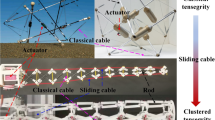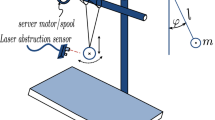Abstract
The chief objective of the current research is to outline an automated technique for deriving the governing equations and also simulating the motions of the multi-closed-chain mechanisms. To this end, the behavior of a mechanical system, whose straight and rigid links are hinged together by perfect rotary joints to make an array of closed loops, will be studied in the two phases of impact and non-impact. For the non-impact phase, in which the said mechanism is only affected by the Earth’s gravity, the relevant differential equations will be derived by the recursive Gibbs–Appell (G–A) methodology (which is a simple approach with fewer partial derivatives to worry about, especially when dealing with the holonomic systems); while for the impact phase, in which at least one joint of the mechanism collides with the surrounding curved wall, the algebraic equations of the system will be obtained by the Newton’s kinematic impact law. One of the most formidable challenges in the current research is the presence of the holonomic constraints that govern the kinematics of the problem. The number of these constraints goes up linearly with the increase in the number of system loops. The other challenges and issues that have been successfully addressed by the presented technique include the oblique impact of the joints of the said mechanism with the surrounding curved wall and the relatively large number of the dependent generalized coordinates needed to define the system configuration. In the suggested approach, after deriving the inverse kinetic equations of the considered mechanism, they are converted to the forward dynamics form in a graphical procedure to simulate the system’s dynamic responses. To demonstrate the capability and the efficacy of the presented technique in deriving the kinetic equations of multi-closed-loop systems, the dynamic behavior of a 5RRR mechanism with 4 closed loops and 10 rigid links is simulated. The simulation results are then validated by means of the work and energy principles.















Similar content being viewed by others
References
Gosselin CM (1996) Parallel computational algorithms for the kinematics and dynamics of planar and spatial parallel manipulators. J Dyn Syst Meas Control Trans ASME 118(1):22–28
Dasgupta B, Choudhury P (1999) General strategy based on the Newton–Euler approach for the dynamic formulation of parallel manipulators. Mech Mach Theory 34(6):801–824
He Z, Song X, Xue D (2016) Comments to the: “closed-form dynamic equations of the general Stewart platform through the Newton-Euler approach” and “ A Newton–Euler formulation for the inverse dynamics of the Stewart platform manipulator.” Mech Mach Theory 102:229–231
Abdellatif H, Heimann B (2009) Computational efficient inverse dynamics of 6-DOF fully parallel manipulators by using the Lagrangian formalism. Mech Mach Theory 44(1):192–207
Raoofian A, Kamali A, Taghvaeipour A (2017) Forward dynamic analysis of parallel robots using modified decoupled natural orthogonal complement method. Mech Mach Theory 115:197–217
Bhattacharya S, Nenchev DN, Uchiyama M (1998) A recursive formula for the inverse of the inertia matrix of a paralel manipulator. Mech Mach Theory 33(7):957–964
My CA, Hoan VM (2019) Kinematic and dynamic analysis of a serial manipulator with local closed loop mechanisms. Vietnam J Mech 41(2):141–155
Staicu S (2009) Dynamics analysis of the Star parallel manipulator. Robot Auton Syst 57(11):1057–1064
Anderson KS (1992) An order n formulation for the motion simulation of general multi-rigid-body constrained systems. Comput Struct 43(3):565–579
Lin GC, Wang DM, Xu LJ, Gao S (2005) The analytical dynamic model of six-DOF industrial robotic manipulators of containing closed chain. Mech Mach Theory 40(4):385–393
Saha SK, Schiehlen WO (2001) Recursive kinematics and dynamics for parallel structured closed-loop multibody systems. Mech Struct Mach 29(2):143–175
Chaudhary H, Saha SK (2007) Balancing of four-bar linkages using maximum recursive dynamic algorithm. Mech Mach Theory 42(2):216–232
Saha SK, Shah SV, Nandihal PV (2013) Evolution of the DeNOC-based dynamic modelling for multibody systems. Mech Sci 4(2013):1–20
Müller A (2016) Local kinematic analysis of closed-loop linkages-mobility, singularities, and shakiness. J Mech Robot 8:1–11
Müller A (2018) Kinematic topology and constrains of multi-loop linkages. Robotica 36(11):1641–1663
Müller A (2021) Wohlhart’s three-loop mechanism : an overconstrained and shaky linkage. Adv Robot Kinemat 15:1–8
De Jong JJ, Müller A, Herder JL (2021) Higher-order derivatives of rigid body dynamics with application to the dynamic balance of spatial linkages. Mech Mach Theory 155:104059
Mata V, Provenzano S, Valero F, Cuadrado JI (2002) Serial-robot dynamics algorithms for moderately large numbers of joints. Mech Mach Theory 37(8):739–755
Korayem MH, Shafei AM, Dehkordi SF (2014) Systematic modeling of a chain of N-flexible link manipulators connected by revolute-prismatic joints using recursive Gibbs–Appell formulation. Arch Appl Mech 84:187–206
Korayem MH, Shafei AM (2015) Motion equation of nonholonomic wheeled mobile robotic manipulator with revolute–prismatic joints using recursive Gibbs-Appell formulation. Appl Math Model 39(5–6):1701–1716
Korayem MH, Shafei AM, Seidi E (2014) Symbolic derivation of governing equations for dual-arm mobile manipulators used in fruit-picking and the pruning of tall trees. Comput Electron Agric 105:95–102
Korayem MH, Shafei AM, Absalan F, Kadkhodaei B, Azimi A (2014) Kinematic and dynamic modeling of viscoelastic robotic manipulators using Timoshenko beam theory: theory and experiment. Int J Adv Manuf Technol 71:1005–1018
Korayem MH, Shafei AM, Doosthoseini M, Absalan F, Kadkhodaei B (2016) Theoretical and experimental investigation of viscoelastic serial robotic manipulators with motors at the joints using Timoshenko beam theory and Gibbs–Appell formulation. Proc Inst Mech Eng Part K J Multi-body Dyn 230:37–51
Korayem MH, Shafei AM (2015) A new approach for dynamic modeling of n-viscoelastic-link robotic manipulators mounted on a mobile base. Nonlinear Dyn 79:2767–2786
Korayem MH, Shafei AM (2009) Motion equations proper for forward dynamics of robotic manipulator with flexible links by using recursive Gibbs-Appell formulation. Sci Iran Trans B Mech Eng 16:479–495
Shafei AM, Shafei HR (2018) Dynamic modeling of tree-type robotic systems by combining 3×3 rotation and 4×4 transformation matrices. Multibody SysDyn 44:367–395
Shafei AM, Shafei HR (2018) Dynamic modeling of planar closed-chain robotic manipulators in flight and impact phases. Mech Mach Theory 126:141–154
Shafei AM, Shafei HR (2019) Considering link flexibility in the dynamic synthesis of closed-loop mechanisms: a general approach. J Vib Acoust 142(2):1–12
Shafei AM, Riahi MM (2022) The effects of mode shapes on the temporal response of flexible closed-loop linkages under the impulse excitation. Mech Syst Signal Process 178, art no. 109256
Lankarani HM, Nikravesh PE (1990) A contact force model with hysteresis damping for impact analysis of multibody systems. J Mech Des Trans ASME 112(3):369–376
Chang CC, Liu CQ, Huston RL (2002) Dynamics of multibody systems subjected to impulsive constraints. Multibody Syst Dyn 8:161–184
Chang CC, Peng ST (2007) Impulsive motion of multibody systems. Multibody Syst Dyn 17:47–70
Glocker C (2013) Energetic consistency conditions for standard impacts: part I: Newton-type inequality impact laws and Kane’s example. Multibody Syst Dyn 29(1):77–117
Hurmuzlu Y, Marghitu DB (1994) Rigid body collisions of planar kinematic chains with multiple contact points. Int J Robot Res 13(1):82–92
Shafei AM, Shafei HR (2016) A systematic method for the hybrid dynamic modeling of open kinematic chains confined in a closed environment. Multibody Syst Dyn 38:21–42
Shafei AM, Shafei HR (2017) Planar multibranch open-loop robotic manipulators subjected to ground collision. J Comput Nonlinear Dyn 12(6):1–14
Shafei AM, Shafei HR (2016) Dynamic behavior of flexible multiple links captured inside a closed space. J Comput Nonlinear Dyn 11(5):1–13
Shafei AM, Shafei HR (2018) Oblique impact of multi-flexible-link systems. J Vib Control 24(5):904–923
Rezaei V, Shafei AM (2018) Dynamic analysis of flexible robotic manipulators constructed of functionally graded materials. Iran J Sci Technol Trans Mech Eng 43:327–342
Shafei AM, Mirzaeinejad H (2021) A novel recursive formulation for dynamic modeling and trajectory tracking control of multi-rigid-link robotic manipulators mounted on a mobile platform. Proc Inst Mech Eng Part I J Syst Control Eng 235(7):1204–1217
Ahmadizadeh M, Shafei AM, Jafari R (2021) frictional impact-contacts in multiple flexible links. Int J Struct Stab Dyn 21(6):2150075
Ahmadizadeh M, Shafei AM, Fooladi M (2021) Dynamic analysis of multiple inclined and frictional impact-contacts in multi-branch robotic systems. Appl Math Model 91:24–42
Ahmadizadeh M, Shafei AM, Fooladi M (2020) A recursive algorithm for dynamics of multiple frictionless impact-contacts in open-loop robotic mechanisms. Mech Mach Theory 146:103745
Ahmadizadeh M, Shafei AM, Fooladi M (2020) Dynamic modeling of closed-chain robotic manipulators in the presence of frictional dynamic forces: a planar case. Mech Based Des Struct Mach. https://doi.org/10.1080/15397734.2021.1966304
Author information
Authors and Affiliations
Corresponding author
Ethics declarations
Conflict of interest
The authors declare that they have no conflict of interest.
Additional information
Publisher's Note
Springer Nature remains neutral with regard to jurisdictional claims in published maps and institutional affiliations.
Rights and permissions
Springer Nature or its licensor holds exclusive rights to this article under a publishing agreement with the author(s) or other rightsholder(s); author self-archiving of the accepted manuscript version of this article is solely governed by the terms of such publishing agreement and applicable law.
About this article
Cite this article
Shafei, A.M., Sadeghi, Z. The kinematics and kinetics of multi-closed-chain mechanisms in the impact and non-impact stages. Meccanica 57, 2591–2608 (2022). https://doi.org/10.1007/s11012-022-01582-w
Received:
Accepted:
Published:
Issue Date:
DOI: https://doi.org/10.1007/s11012-022-01582-w




